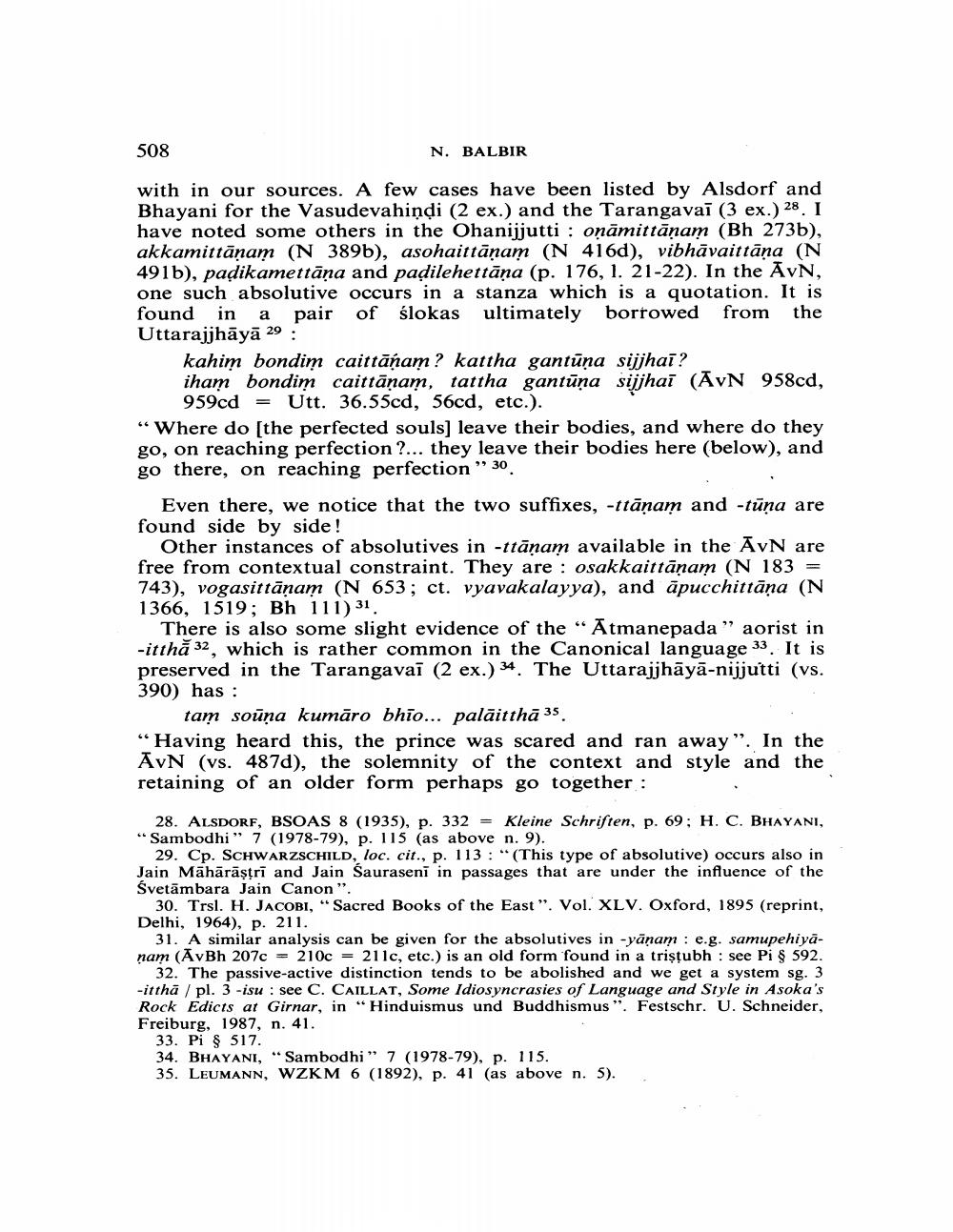Book Title: Morphological Evidence For Dialectal Variety In Jaina Maharastri Author(s): Nalini Balbir Publisher: Nalini Balbir View full book textPage 6
________________ 508 N. BALBIR with in our sources. A few cases have been listed by Alsdorf and Bhayani for the Vasudevahindi (2 ex.) and the Tarangavai (3 ex.) 28 I have noted some others in the Ohanijjutti : onāmittānam (Bh 273b), akkamittānam (N 389b), asohaittānam (N 416d), vibhāvaittāņa (N 491b), padikamettāna and padilehettāna (p. 176, 1. 21-22). In the AVN, one such absolutive occurs in a stanza which is a quotation. It is found in a pair of ślokas ultimately borrowed from the Uttarajjhāyā 29 : kahim bondim caittānam ? kattha gantūņa sijjhai ? iham bondim caittānam, tattha gantūņa sijjhai (ĀvN 958cd, 959cd = Utt. 36.55cd, 56cd, etc.). "Where do [the perfected souls) leave their bodies, and where do they go, on reaching perfection ?... they leave their bodies here (below), and go there, on reaching perfection " 30. Even there, we notice that the two suffixes, -ttāṇam and -tūņa are found side by side! Other instances of absolutives in -ttānam available in the ĀvN are free from contextual constraint. They are : osakkaittānam (N 183 = 743), vogasittānam (N 653; ct. vyavakalayya), and apucchittāna (N 1366, 1519; Bh 111) 31. There is also some slight evidence of the “Ātmanepada" aorist in -itthă 32, which is rather common in the Canonical language 33. It is preserved in the Tarangavai (2 ex.) 34. The Uttarajjhāyā-nijjutti (vs. 390) has : tam souņa kumāro bhio... palāitthā 35. “Having heard this, the prince was scared and ran away". In the AvN (vs. 487d), the solemnity of the context and style and the retaining of an older form perhaps go together : 28. ALSDORF, BSOAS 8 (1935), p. 332 = Kleine Schriften, p. 69: H. C. BHAYANI, "Sambodhi" 7 (1978-79), p. 115 (as above n. 9). 29. Cp. SCHWARZSCHILD, loc. cit., p. 113:"(This type of absolutive) occurs also in Jain Māhārāștri and Jain Sauraseni in passages that are under the influence of the Śvetāmbara Jain Canon". 30. Trsl. H. JACOBI, “Sacred Books of the East". Vol. XLV. Oxford, 1895 (reprint, Delhi, 1964), p. 211. 31. A similar analysis can be given for the absolutives in - yānam : e.g. samupehiyanam (AvBh 207c = 210c = 211c, etc.) is an old form found in a triştubh : see Pi 8 592. 32. The passive-active distinction tends to be abolished and we get a system sg. 3 -itthā / pl. 3 -isu : see C. CAILLAT, Some Idiosyncrasies of Language and Style in Asoka's Rock Edicts at Girnar, in “Hinduismus und Buddhismus". Festschr. U. Schneider, Freiburg, 1987, n. 41. 33. Pi § 517. 34. BHAYANI, “Sambodhi” 7 (1978-79), p. 115. 35. LEUMANN, WZKM 6 (1892), p. 41 (as above n. 5).Page Navigation
1 ... 4 5 6 7 8 9 10 11 12 13 14 15 16 17 18 19 20 21 22 23
